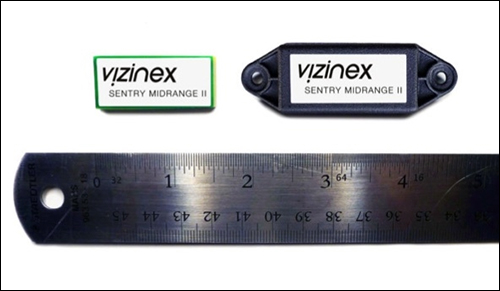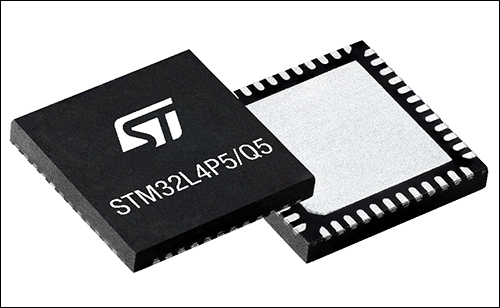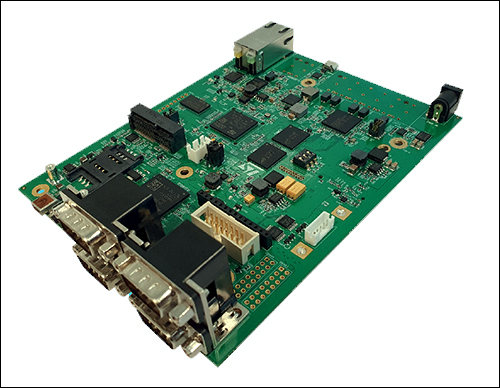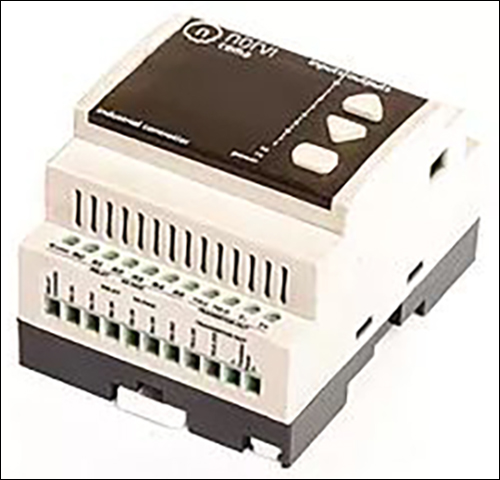Presented here are news announcements made during the past week by the following organizations:
Vizinex RFID;
STMicroelectronics;
NGK Insulators; and
NORVI.
Vizinex RFID Intros Tags for Tracking Large Metal Assets
Vizinex RFID, which manufactures RFID tags for specific applications, has launched its Sentry Midrange II, the second generation of the company’s tag for tracking large metal assets. With a read range of 25 feet when mounted on metal, the Sentry Midrange II allows for the tagging of a variety of assets, the company reports, including reusable containers, oil-field assets and construction equipment.
The Sentry Midrange II is 30 percent smaller than its predecessor, according to the company, but provides a broader frequency response. The tag’s optional cover provides extra protection for the RF device and the flexibility to use bolts, rivets or zip-ties for attachment. Industries that use this type of RFID tag include government, military, manufacturing, waste management, rental equipment, and oil and gas. Applications include special transport items, reusable containers, logistics and yard management, and tool and die tracking.

“Improvements in RF chip design and Vizinex’s expertise at matching the new chips to highly efficient antennas is improving the performance and reducing the cost of RFID,” said Bob Oberle, Vizinex RFID’s co-founder and chief technology officer, in a prepared statement. “The rugged Sentry Midrange II is tolerant of repeated exposure to high temperatures, vibration and impact.”
The Sentry line of application-specific tags is based on a printed circuit board platform. The manufacturing process offers reliability and consistency in read-range performance, according to the company. The tag features a fiber-reinforced composite material that provides ruggedness, while its patented design enables fast prototyping and affordable customization.
STMicroelectronics Offers Smart Device Microcontrollers, Smart Gateway Platform
STMicroelectronics has announced that its STM32L4P5 and STM32L4Q5 microcontrollers (MCUs) feature an Arm Cortex-M4 core and are suitable for smart connected devices, including utility meters, industrial and medical sensors, fitness trackers and smart-home products. Memory density is at 512KB Flash and 320KB SRAM, the company reports. Compact 10-millimeter by 10-millimeter 64-pin and 7-millimeter by 7-millimeter 48-pin package options let designers tackle applications limited by size constraints, the company reports, such as wearable form factors.
The system features independent power connections for circuitry, such as USB and analog peripherals, independent clock domains, and Octal and Quad SPI interfaces for external memory expansion. The devices come with a 5Msample/s smart analog-to-digital converter (ADC) that can operate at full speed to minimize acquisition time, or at reduced speed with lower current.

Leveraging ST’s ultra-low-power microcontroller technologies, the STM32L4+ MCUs feature seven main low-power modes that let designers manage power consumption and wake-up times to minimize energy demand. The devices support FlexPowerControl, which ensures the energy-efficient handling of processing loads, as well as Batch Acquisition Mode for energy-efficient data capture while the CPU is stopped.
Other features preserve system reliability and safety in industrial and medical applications, including Flash error-correcting code support and hardware parity checking for SRAM. Cyber-protection features include a True Random Number Generator and IP protection through limited access to code stored in internal memory. STM32L4Q5 devices feature additional cryptographic accelerators that support AES, RSA, DH and ECC acceleration.
ST has extended the STM32 development ecosystem by introducing the NUCLEO-L4P5ZG Nucleo-144 board and STM32L4P5G-DK Discovery kit, each containing an STM32L4P5 microcontroller. Leveraging the STM32Cube ecosystem, the STM32L4P5 and STM32L4Q5 are supported by the STM32CubeL4 MCU package, which contains a hardware abstraction layer and low-layer (HAL/LL) peripheral drivers, middleware components and example projects, and by the STM32CubeMX initialization-code generator and configurator, which has a power-consumption calculator for low-power design.
In addition, the company’s Smart Gateway Platform (SGP) provides a development tool for prototyping automotive smart-gateway and domain-controller applications. The evolution of automotive architectures to include high throughput in-vehicle networking and high data-rate connectivity to the cloud has increased demand for high-performance smart-gateway and domain-controller electronic control units, the company reports.

ST’s modular SGP, built on gigabit Ethernet communication between the secure and ASIL-B Telemaco3P microprocessor and the ASIL-D SPC58/Chorus microcontroller, offers the processing capability to handle firewall functionalities, predictive maintenance, over-the-air upgrades, and high data-rate communication among different ECUs and to the cloud. While the Chorus MCU provides real-time, low-power and secure in-vehicle connectivity through its multiple CAN-FD interfaces, the Telemaco3P MPU extends gateway computational capabilities by delivering dual Arm Cortex A7 processing power with the Posix OS support and an embedded security module to handle OTA updates, firewall and predictive-maintenance functions.
The SGP reference design features in-vehicle network interfaces, including Ethernet and CAN ports, as well as support for LIN and FlexRay connections. It comes with a starter package that includes hardware design files, hardware and software documentation, software utilities (drivers and flashers), and sample applications. The SGP integrates expansion connections to Wi-Fi and LTE modules for full prototyping of use cases requiring cloud-connectivity simulation.
NGK Insulators Releases Lithium-Ion Battery for IoT Devices
NGK Insulators reports that several new Internet of Things (IoT) devices have been introduced for the health-care, mobility and agriculture sectors, but the development of these devices has brought forth issues in power supply maintenance, as the majority of batteries face capacity issues—and with rechargeable batteries, charging time and battery lifespan can pose problems. Therefore, the company introduced its Coin and Pouch batteries, part of its EnerCera series of products.
The EnerCera Coin, measuring 1 to 2 millimeters in thickness, is intended for mounting on a circuit board, while the EnerCera Pouch, an ultra-thin and bendable cell, measures 0.4 to 0.45 millimeter in thickness, for embedding in a card. EnerCera Coins are made by adding a small amount of liquid electrolyte to its all-ceramic stacked monolithic body with electrodes and separator. NGK defines these batteries as “Semi-Solid State.” The lithium-ion secondary batteries have an operating temperature of 85 degrees Celsius, with a lifespan of up to 10 years, suitable for IoT devices.
The EnerCera line is intended for use in energy harvesting. In addition to storing small amounts of electrical currents, it can release large currents when needed, similar to capacitors. This feature allows EnerCera to be used as a maintenance-free power supply solution in an ultra-small, ultra-thin package.
In industrial markets, one of the largest potential applications for EnerCera is as the power source for monitoring piping, or other tasks inherently difficult for humans to conduct alone. In addition, the company reports, there is the potential for process management for factories, lighting and air-conditioning management for buildings and equipment monitoring, by utilizing EnerCera with energy harvesting or a wireless power supply.
NORVI Expands Its Industrial IoT Offerings
NORVI‘s line of programmable Industrial Internet of Things (IIoT) devices include the NORVI IIOT and NORVI Arita with an ESP32 system-on-chip. The company has released seven expansion modules: NB-IOT with BC95-G; LoRa with Reyax; analog (0-10V); analog (4-20mA); temperature (thermocouple); temperature (RTD); and load cell. All of the modules communicate with the controller via an expansion port on the side of the device.
In addition, the company has launched the NORVI Agent 1, with a lesser input count than the NORVI IIOT, and with the option of choosing a microcontroller type depending on the application. The device comes with either an ESP32-WROVER32 or STM32L series ultra-low-power microcontroller. As communication options, NB-IoT and LoRA come built in. The NORVI Agent 2, meanwhile, is designed for panel-mount applications with ESP32-WROOM32. It has a 0.96 OLED display for use in monitoring and diagnosing applications. The NORVI Cema Industrial Arduino is a compact version of the NORVI series with eight outputs and eight inputs. Two transistor outputs add PWM or Pulse output capabilities. The device comes with a six-pin expansion port with serial output and is intended for use in industrial environments.

The NORVI IIOT ESP32 is suitable for industrial environments and comes with Arduino and ESP-IDF USB programmable industrial ESP32, with an OLED display and a din-rail mount. It is designed for protection and reliability and complies with 2014/30/EU- Electromagnetic Compatibility (EMC) Annex III, Part B, Module C (Conformity to Type Based on Internal Production Control). The NORVI Arita is a higher-capacity version with a choice of two microprocessors. Arita is compatible with most industrial input and output types, the company reports, and includes all industrially accepted communication methods.
The Agent One Industrial IoT Node features multiple processor and communication options. It can be used in various applications, ranging from Industrial IoT to a simple data logger. It can be ordered with ESP32-WROVER-B or with an ultra-low-power STM32L151xE. The Industrial ESP32 Node supports LoRa, NB-IoT and Wi-Fi communication. The Agent Two Panel Mount IoT Node features an ESP32-WROOM SoC, built into a panel-mount device, for applications requiring a tiny display. A front-mount USB port provides easy access to programming, while a button connected to GPIO provides facility for user inputs.

